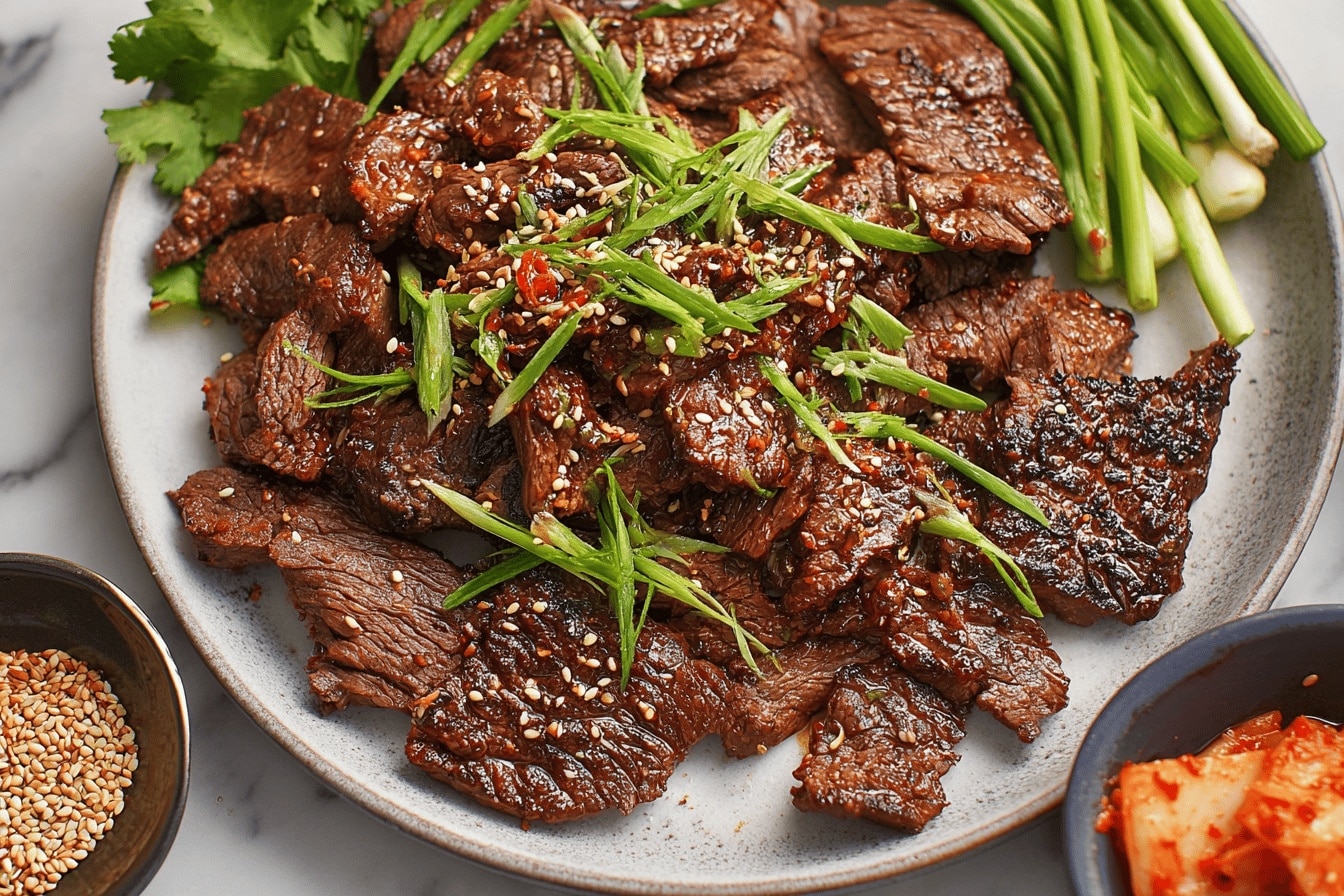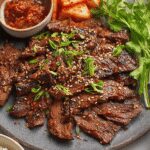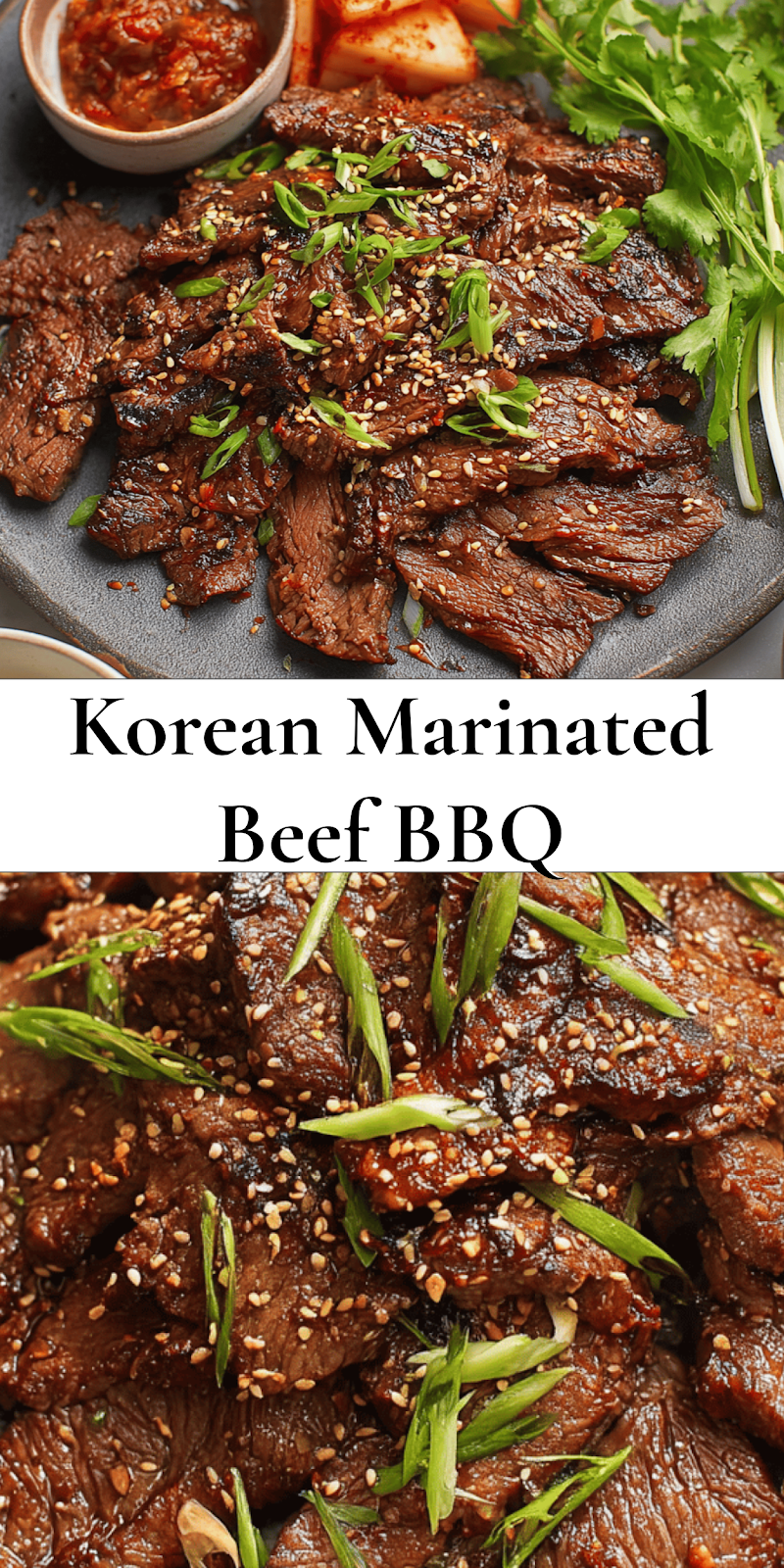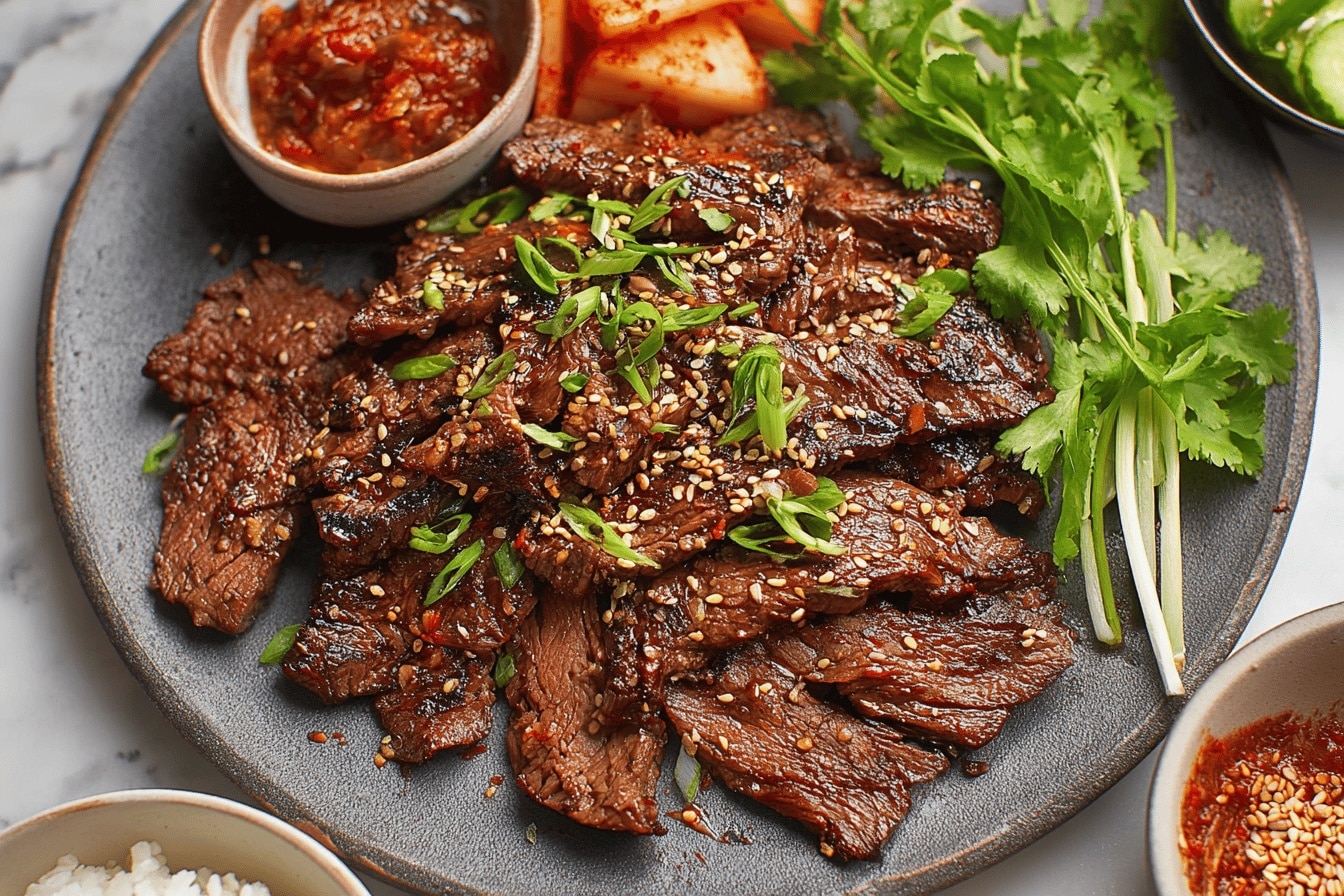Introduction
There’s something incredibly comforting about discovering a dish that feels like a warm hug right from the first bite. Korean Beef Bulgogi is one of those dishes for me—flavorful, approachable, and somehow endlessly satisfying, even when my kitchen looks like a minor disaster zone. I didn’t start out as someone who could confidently whip up meals. In fact, my early cooking adventures often ended with burnt toast or a pan left forgotten on the stove. But slowly, I found joy in the little wins, the messy tries, and everything in between. What’s beautiful about bulgogi is how it turns simple ingredients—thinly sliced beef, a mix of savory and sweet flavors, a splash of sesame oil—into something that feels special without needing a master’s degree in cooking. I remember the first time I made it; the marinade was a bit off (too salty, not sweet enough), and I may have overcooked the meat just a tad. But somehow, that imperfect batch still brought smiles and second helpings around the table. It’s a reminder that cooking isn’t about perfection. It’s about experimenting, tweaking, and most importantly, enjoying the process… spills, splatters, and all. This dish also taught me that you don’t need fancy tools or complicated steps to create something exciting in your kitchen. A mixing bowl, a knife, and a cast iron skillet were all I used to transform a few humble ingredients into a meal that felt like a celebration. Bulgogi has become my go-to when I want something quick but with a bit of flair—not to mention, it’s a fantastic way to invite friends over and share a slice of Korean flavor without much fuss. In the end, Korean Beef Bulgogi isn’t just a recipe, it’s a little kitchen adventure that brings out the best in simple cooking and encourages you to embrace every win, flop, and delicious surprise along the way.why you should love this recipe :
Oh, bulgogi—there’s something about that sweet, savory, smoky goodness that just hits different, right? It’s like a flavor party on your tongue and somehow it manages to feel both comforting and exciting at the same time. Honestly, this recipe doesn’t require fancy kitchen gadgets or complicated marinating techniques. Just a simple cast iron grill pan and a few ingredients you might already have on hand. And listen, if you’ve never used pear in meat marinades before, you’re in for a surprise. That subtle sweetness and tenderizing magic it brings? Total game changer. I remember the first time I made this, I was supposed to slice the steak thinly after chilling it in the freezer for a short bit—but I got distracted halfway through and sliced one piece too thick. Instead of tossing it, I actually ended up tearing it into smaller strips while cooking, and it gave me that nice rustic edge I now love about this dish. So, hey, imperfections are totally part of the charm here. When that steak hits the grill pan and starts sizzling, the smell alone practically pulls family or friends to the kitchen like some kind of savory magnet. The toasted sesame oil and a little kick of gochujang keep the layers of flavor interesting without being overpowering. Plus, grilling the meat quickly on high heat keeps it juicy and tender, which is just what you want when you’re craving that authentic Korean beef experience. Top it all off with some scallions and sesame seeds and you have a dish that’s as pretty as it is tasty. Perfect for a weeknight dinner that somehow feels special.Ingredients and measurement :
1 ½ pounds boneless rib eye steak ½ small pear, peeled and coarsely grated ¼ cup reduced sodium soy sauce 2 tablespoons brown sugar 2 tablespoons toasted sesame oil 3 cloves garlic, minced 1 tablespoon freshly grated ginger 1 tablespoon gochujang, Korean red pepper paste 2 tablespoons vegetable oil, divided 2 green onions, thinly sliced 1 teaspoon toasted sesame seedsPreparing time
Allow about 15 minutes for prep, plus at least 2 hours of marinating (or overnight if you can plan ahead).Cooking time :
Plan for roughly 10-15 minutes total grill time, depending on how many batches you cook.Instructions :
Step 1: Chill and slice the steak
Wrap your rib eye in plastic wrap and pop it into the freezer for 30 minutes. This firms up the meat, making it way easier to slice thinly. When it’s ready, remove the wrap and cut across the grain into ¼-inch thick slices. Don’t stress if one or two slices end up a little thicker—just roll with it.Step 2: Mix the marinade
In a medium bowl, stir together the grated pear, soy sauce, brown sugar, toasted sesame oil, minced garlic, freshly grated ginger, and gochujang. The pear is the secret magic here—its enzymes tenderize the meat while adding a subtle sweetness that keeps things balanced.Step 3: Marinate the steak
Place your sliced steak and the marinade into a large gallon-size zip bag. Seal it up and squish everything around to coat the meat evenly. Set it in the fridge for at least 2 hours, but don’t be shy about leaving it in overnight if you’ve got the time. Every so often, turn the bag to make sure all those flavors keep mingling.Step 4: Heat and oil the grill pan
Heat 1 tablespoon of vegetable oil in your cast iron grill pan over medium-high heat. When it’s shimmering, you’re good to go.Step 5: Cook the steak in batches
Lay your steak slices in a single layer without crowding the pan. Cook for 2-3 minutes on one side until you get that beautiful char, then flip and cook another 2-3 minutes. Repeat with the remaining oil and steak. Remember, the key is a quick cook on high heat so the beef stays juicy and tender.Step 6: Serve it up
Plate immediately and sprinkle sliced green onions and toasted sesame seeds on top. If you’re like me, you’ll want to eat this straight off the pan while it’s piping hot.Notes :
Marinating time matters
You can technically cook the beef after just an hour, but the pear and spices need some time to really get those tenderizing and flavor-building powers going. Overnight is my personal fave when I can swing it.Don’t overcrowd the pan
To get the best char and avoid steaming your steak, cook in batches. Overcrowding will suck the heat out of the pan and give you a sad, soggy bite.Going pear-free?
If you don’t have pear, try using finely grated apple instead. Just remember it’s a natural tenderizer that balances sweet and umami, so it’s an important flavor and texture player here.Watch your grill pan closely
Cast iron retains heat like a beast. If you see smoke or burning, turn the heat down a notch. Nobody wants scorched bulgogi!Leftovers
If you have any (and who does?), this bulgogi reheats wonderfully in a hot skillet or even tossed into rice or noodles for a quick lunch. Just don’t overcook it when reheating!
Cooking tips : Preparing the Beef
Chill before slicing
Wrapping the rib eye in plastic and popping it in the freezer for 30 minutes makes a huge difference — it firms up the meat so you can slice it super thin and evenly without it turning into a messy mush. Trust me, I learned this the hard way when my knife just kept slipping and I ended up with chunky hunks rather than those perfect thin strips.Marinate longer for deeper flavor
Sure, you can marinate for just a couple of hours, but if you’ve got the patience (or the forgetfulness to leave it overnight in the fridge), the flavors really soak in beautifully. The pear tenderizes the meat naturally, which is a total game changer — no need to worry about tough bites. I once rushed this step and instantly regretted it with a chewy batch.Don’t overcrowd the pan
When it comes time to cook, giving your steak slices room in that cast iron grill pan is key. I learned the hard way when I crammed too many pieces in and ended up with steaming meat instead of that beautiful char. Cook in batches, flip only once, and let them develop those nice grill marks.Cooking tips : Flavor & Garnish
Balance spicy and sweet
The gochujang brings a gentle heat but mixed with brown sugar and pear, it becomes this beautiful sweet-umami combo. If you’re sensitive to spice, ease up on that paste just a tad — I always keep it mild for my kids and still get plenty of flavor.Toasting sesame seeds is worth it
I used to skip this step, thinking it was just garnish. Oh no. Toasting those sesame seeds ahead adds that subtle nutty crunch that surprisingly boosts the whole dish. It’s a little extra step but so worth the tiny mess.FAQ: Bulgogi Basics
Can I use a different cut of beef?
Absolutely! Rib eye is perfect because it’s tender and flavorful, but flank steak or sirloin work well too—just slice thin across the grain, and adjust the cooking time slightly.What if I don’t have a cast iron grill pan?
No worries! A regular skillet or non-stick frying pan works fine. You won’t get those trademark grill marks, but the marinade and sear still deliver deliciousness.Can I make it less spicy?
Yes. Gochujang adds heat, but you can reduce the amount or skip it entirely and maybe toss in a splash of mild chili sauce if you want a gentler kick.Is pear necessary in the marinade?
The pear really helps tenderize and sweeten, but if you can’t find it, apples or even a bit of pineapple juice can substitute. Just keep an eye on it so it doesn’t overly soften the meat.How do I store leftovers?
Cool completely, then pop into an airtight container in the fridge for up to 3 days. Reheat gently in a pan over medium heat to keep it juicy rather than drying out in the microwave. Print
Korean Beef Bulgogi
- Total Time: 36
- Yield: 4 persons
Description
Korean Beef Bulgogi is a flavorful and tender dish made with thinly sliced beef that is marinated in a savory and slightly sweet sauce. This popular Korean recipe is known for its delicious combination of soy sauce and garlic with a hint of sweetness. The beef is then grilled or pan-cooked to bring out its rich flavors and caramelized edges making it a perfect main course for a comforting meal.
Ingredients
1 ½ pounds boneless rib eye steak
½ small pear, peeled and coarsely grated
¼ cup reduced sodium soy sauce
2 tablespoons brown sugar
2 tablespoons toasted sesame oil
3 cloves garlic, minced
1 tablespoon freshly grated ginger
1 tablespoon gochujang, Korean red pepper paste
2 tablespoons vegetable oil, divided
2 green onions, thinly sliced
1 teaspoon toasted sesame seeds
Instructions
Wrap the steak in plastic wrap and place in the freezer for 30 minutes. Remove from the freezer, unwrap, and slice across the grain into 1/4-inch thick slices.
In a medium bowl, combine the grated pear, soy sauce, brown sugar, sesame oil, garlic, ginger, and gochujang. Transfer the soy sauce mixture and steak into a gallon-size Ziploc bag and marinate for at least 2 hours or up to overnight, turning the bag occasionally to evenly coat the meat.
Heat 1 tablespoon of vegetable oil in a cast iron grill pan over medium-high heat. Working in batches, place the steak slices in a single layer in the pan. Cook, flipping once, until the meat is nicely charred and cooked through, about 2-3 minutes per side. Repeat with the remaining 1 tablespoon of vegetable oil and the rest of the steak.
Serve the steak immediately, garnished with sliced green onions and toasted sesame seeds if desired.
Notes
Korean Beef Bulgogi is best marinated overnight for deeper flavor
Avoid overcooking to keep beef tender
Use a hot pan for a nice sear
Rest the meat before serving to retain juices
Serve with fresh vegetables for balance
- Prep Time: 30
- Cook Time: 4-6
- Method: Grilling
- Cuisine: Korean
Nutrition
- Calories: 414
Conclusion
This marinated rib eye steak really hits that perfect spot between sweet, savory, and a little kick of spice. The grated pear sneaks in a subtle sweetness and tenderizes the meat just right, making every bite melt in your mouth. Using the cast iron grill pan gives it those beautiful char marks that make it look like you spent hours fussing over it, when really, it’s pretty straightforward. I’ve gotta admit, sometimes I overcook a slice or two because I got distracted scrolling on my phone—oops—but even then, the flavors still shine through. Garnishing with green onions and sesame seeds adds that final touch of freshness and crunch that makes you want to go back for more. Definitely a recipe to keep in your back pocket for impressing friends or just treating yourself after a long day.Suggestions of another similar recipes
Korean BBQ Chicken Thighs with Gochujang Marinade
Try swapping the steak for boneless chicken thighs, marinated with the same pear, gochujang, and sesame oil combo. The thighs soak up the flavors beautifully and cook up juicy and tender on the grill pan.Spicy Beef Bulgogi Lettuce Wraps
Slice the marinated steak thinner and serve it wrapped in fresh lettuce leaves with shredded carrots, cucumber, and extra green onions. It’s a fun, hand-held way to enjoy all those bold flavors without any fuss.Ginger and Garlic Sesame Noodles with Grilled Steak
Toss cooked noodles in a sauce made from soy sauce, sesame oil, grated ginger, and garlic, and top with sliced grilled steak and a sprinkle of sesame seeds. It’s a quick weeknight dinner that feels a little fancy without the hassle.Miso-Ginger Glazed Eggplant with Toasted Sesame
For a veggie option, roast eggplant slices brushed with a miso-ginger glaze, then finish with toasted sesame seeds and green onions. It’s a rich, umami-packed dish that pairs beautifully alongside or instead of steak for a lighter meal.

